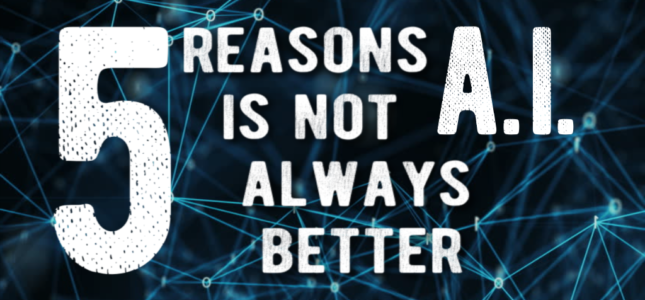Technology is constantly developing with new options and ways of managing digital details emerging all the time. In many cases, the increased acceptance of things like Artificial Intelligence and automation can deliver better results than we could have imagined just a few years ago.
However, even though AI is beneficial in some instances, there remain times where good old-fashioned manual activity is the best option. As an experienced digital ad services manager, I’ve seen various developments come through. Some of them end up becoming a huge plus for the digital ad campaign world – but that’s usually after a lot of testing and many tweaks to get them working in the right way.
When it comes to AI and digital ads, there are some elements that, even after a couple of years of testing, can’t compete with that real human touch. Let’s take a look at five elements of AI in digital ads that, for the most part, aren’t even close to surpassing the success of human management. And enjoy some of my favourite robotic fail GIFs along the way.
1. Data Overload
If you’re considering using the AI elements of Google Ads or Bing Ads to allow you to concentrate on other elements of your advertising campaign, then the AI automated options that are available could make sense. Provided, that is, that you have enough data to ensure the AI can make the best decisions with regards to the campaign it creates or any changes you allow it to make to your bidding structures.
Where a process is complex and takes time for humans to manage and get right, to enable AI to take it on and achieve the best results, requires as much information as possible to be made available. In addition, all of that data has to be relevant and 100% correct to ensure no mistakes are made when the algorithm gets to work.
That means AI in digital ads for start-ups, businesses adding new lines or re-aligning their values and customers will almost always be beaten by digital ad results form human input and management. Even if you’re a mature business, if the historical data you use is irrelevant to your market/product/services today, then it could mean the decisions that AI tech makes isn’t quite right for your business Ad needs.
2. Automated Bidding

Again, this AI powered option initially looks like a good one and it can work well for some businesses. However, if you’re looking to save money on your digital ad spend, it’s rarely the best decision.
That’s because even though automated bidding works within the range you set and won’t go above your maximum, its aim is to maximise the engagement with your ads. Where you still want to have digital ads displayed to the right people but are keen to limit your spending, the AI powered automated function won’t be effective for that strategy – but human management is well equipped to achieve your dual goal.
3. Auto Adjust Ad Wording

There are some instance were the Google ad ability to automatically adjust the wording in your digital ads to suit search terms can work. But there are also plenty of situations where it won’t.
In super specific niche areas of business, the keywords you’ve used for your ad have been painstakingly selected to ensure they’re only relevant to your very specific audience. If the responsive search ads tool changes one or more words in your ads to match more popular search terms, you could end up with two negative outcomes:
- You lose your key audience as your automatically modified ad wording no longer fits their requirements.
- When your brand features in the results of more searches but isn’t relevant, users could begin to think negatively about your business.
Maximise Clicks

Google’s automated bidding gives the ability to automatically make relevant changes to your ads to achieve the highest number of clicks on it while remaining within your specified budget. While this sounds great in theory, clicks don’t always translate into conversions.
That means that while your click-throughs from the ad to your landing page are higher, your final customer conversion rate could fall. Even if that happens within your budget, the result isn’t great as your cost per conversion could rise.
Even if you’re just looking to increase engagement, this is probably not the best use of your budget, even if it does cost your team a little less time.
AI Optimising Time

As number one on this list highlights, for AI to work well in Google Ads or other digital ad campaigns, a lot of reliable data is required. That’s not just the historical data, it’s the current information that is being created through the process of your current digital ad campaign too.
If you want a quick win, or even one within a reasonable timeframe, using AI ad tools is probably not the best option as, just like when a person mange your digital ad campaign, there is testing, trail and error involved. Even though you’re not the one doing the testing and analysing the data, what can take the ad AI tool days to notice is often spotted within hours by an experienced digital ad professional.
I’m not saying that AI in the digital ad world is a no go. What Iam are saying is that if you have specific goals in mind and a budget you have to stick to, then human management of your digital ad campaign is pretty much always the best option for your business.
That’s not to say that some helpful automated additions to that campaign can’t be helpful. But knowing when to use them and when to stick with physical brain power is yet another essential ingredient to creating and managing a successful digital ad campaign.
What do you think about AI in advertising? Have any horror stories to share. Pop them in the comments.

